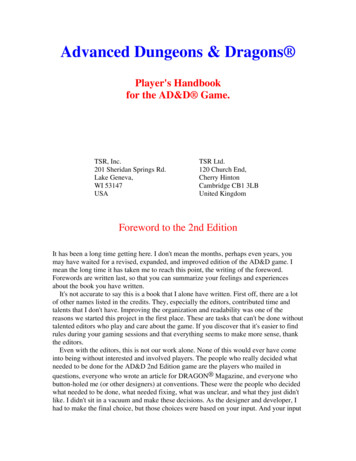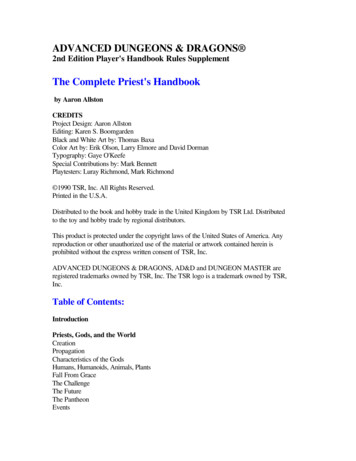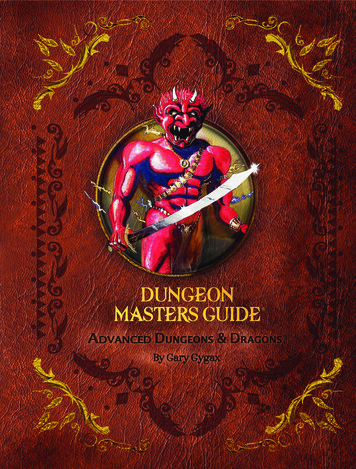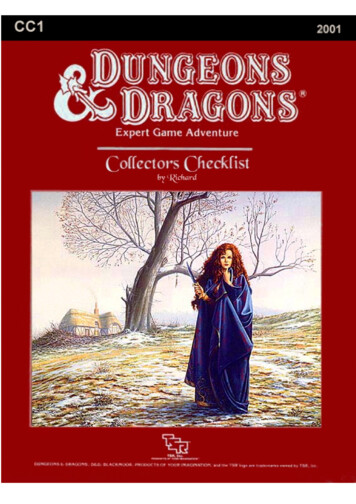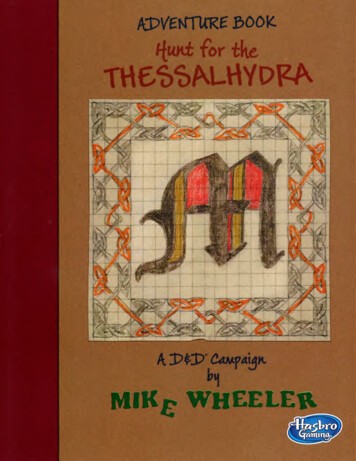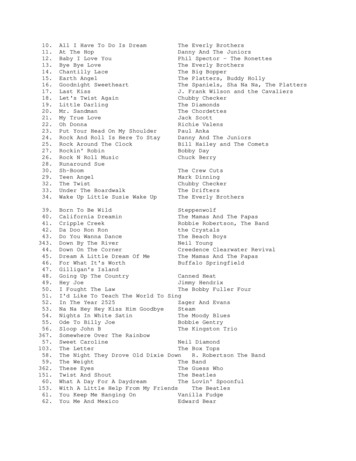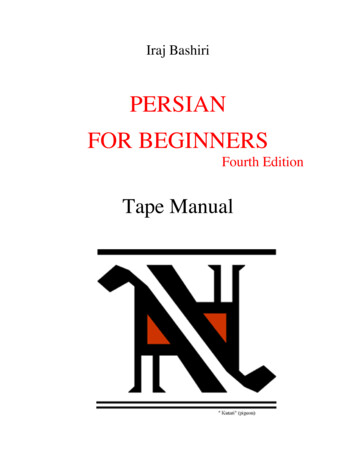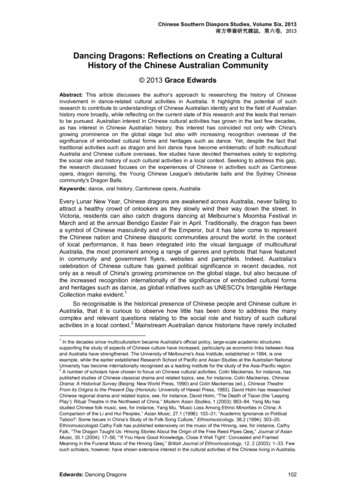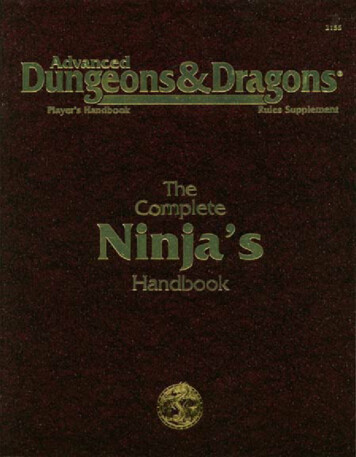
Transcription
ADVANCED DUNGEONS & DRAGONS 2nd Edition Player's Handbook Rules SupplementThe Complete Ninja's HandbookBy Aaron AllstonCREDITSDesign: Aaron AllstonEditing: Barbara G. YoungBlack and White Art: Jim HollowayColor Art: Clyde Caldwell, Fred Fields,Les DorscheidTypography: Tracey IslerProduction: Paul HanchetteAcknowledgements: Many elements of The Complete Ninja's Handbook were derived from partsof Oriental Adventures designed by David "Zeb" Cook. In particular, portions of the optionalAdvanced Martial Arts rules are drawn from Oriental Adventures.TSR, Inc.201 Sheridan Springs Rd.Lake GenevaWI 53147USATSR Ltd.120 Church End,Cherry HintonCambridge CB1 3LBUnited KingdomADVANCED DUNGEONS & DRAGONS, AD&D, DRAGON, and DUNGEON MASTER areregistered trademarks owned by TSR, Inc. The TSR logo is a trademark owned by TSR, Inc.This book is protected under the copyright laws of the United States of America. Anyreproduction or unauthorized use of the material or artwork contained herein is prohibitedwithout the express written permission of TSR, Inc.Random House and its affiliate companies have worldwide distribution rights in the booktrade for English language products of TSR, Inc. Distributed to the book and hobby trade in theUnited Kingdom by TSR Ltd. Distributed to the toy and hobby trade by regional distributors. 1995 TSR, Inc. All rights reserved. Printed in the U.S.A.Table of ContentsIntroductionChapter 1: The Ninja ClassNinja and RogueNinja Experience LevelsNinja Class RequirementsAlignment
Weapons and ArmorThieving SkillsNinja's FollowersNonweapon ProficienciesStarting MoneyMulticlass NinjaDual-class NinjaOther Character Creation NotesChapter 2: Ninja KitsKit DescriptionsNinja KitsStealer-InShadow WarriorIntruderConsortPathfinderLone WolfSpirit WarriorNinja SpellsFirst-Level SpellsSecond-Level SpellsThird-Level SpellsFourth-Level SpellsFifth-Level SpellsSixth-Level SpellsChapter 3: Shinobi, Spies, and KillersShinobiShinobi FighterShinobi RangerShinobi MageShinobi IllusionistShinobi PriestShinobi ThiefShinobi BardSpiesThe Foreign ServiceNinja Kits and the SpyWhat the Spy DoesDemihuman SpiesKillersRestrictionsKiller KitsChapter 4: Proficiencies and Martial ArtsWeapon ProficienciesWeapon Specializationand Weapon GroupsNonweapon Proficiencies
Nonweapon Proficienciesfrom the Player's HandbookNew Nonweapon ProficienciesNew NonweaponProficiency DescriptionsMartial ArtsMartial Arts ResultsSpecializing in Martial ArtsMixed CampaignsAdvanced Martial Arts (Optional)Prerequisites to Learning Martial ArtsFinding a MasterTraining Under the MasterLearning the StylePre-Campaign LearningMultiple StylesStyle CharacteristicsCreating a New Style: BasicsCreating a New Style: WeaponsCreating a New Style:Special ManeuversArmed and Armored OpponentsStunning and IncapacitatingHit LocationsChapter 5: Tools of the TradeWeaponsEntangling AttacksProne and Entangled OpponentsWeapon ListMissile Weapon RangesArmorMiscellaneous EquipmentWeapon ModificationsMagical and Special TreasuresMiscellaneous MagicMagical WeaponsChapter 6: Country and ClanLand of the NinjaThe Ninja ClanChapter 7: Playing the NinjaNinja in the Outer WorldNinja in a Non-Ninja PartyAn All-Ninja PartyPlaying The Lone WolfChapter 8: Campaigning the NinjaSecrecy Within the CampaignThe Character Mix
Ninja AdventuresNinja Kits in the CampaignNinja Clan ResourcesSpy CampaignsChapter 9: ExamplesExamples of Ninja CharactersExamples of Ninja ClansOther Ninja-Type OrganizationsTables1: Rogue Experience Levels2: Ninja Thieving Skill Base Scores3: Thieving Skill Dexterity Adjustments4: Backstab Damage Multipliers5: Thieving Skill Armor Adjustments6: Clan Status7: Spirit Warrior Spell Progression8: Spirit Warrior Experience Levels9: Shinobi Thief Base Scores10: Shinobi Bard Base Scores11: Proficiency Costs12: Nonweapon Proficiency Groups13: Broad and Tight Weapon Groups14: Enamor Proficiency Results15: Escape Proficiency Penalties16: Martial Arts Results17: Common Martial Arts Styles18: Martial Style Combinations19: Special Maneuvers20: Ch'i Attacks21: Penalties and Bonuses Vs. Armored Opponents22: Penalties Vs. Armed Opponents23: Martial Arts Hit Locations24: Weapon List25: Missile Weapon Ranges26: Miscellaneous Equipment27: Weapon Modifications28: Ninja Clan Alignments29: Clan Member Alignments30: Ninja Clan ResourcesIntroductionWhat is a ninja? Everywhere you turn, you find a different definition, especially in the
movies. Is the ninja a cruel supernatural assassin with godlike powers of invisibility, illusion, andteleportation? A modern, feeling Oriental man with family, job responsibilities, and an interestingdouble life? A stone-faced westerner who miraculously inherits the duties of an ancient ninja clantradition when his adopted brother is slain? A martial arts practitioner celebrating hundreds ofyears of unbroken tradition?In the AD&D game, the ninja is a highly trained spy who is expert in matters of intrusion,sabotage, and elimination. He is part of a tight-knit clan whose profession and goals he shares.Some ninja are generalists, equally at home in matters of stealth and combat. Some arespecialists, becoming adept at social skills, magic, or interaction with nature.They're all exotic, secretive, and dangerous—just the thing for the player who's tired of standup fighters, clean-cut clerics, and nearsighted scholar-mages.Ninja have been here before, in the pages of DRAGON Magazine and the OrientalAdventures supplement. Now they return, slinking into the game's shadows in their night-suits,learning the balance of weapons and tools made a little unfamiliar by adaptation to AD&D 2ndEdition rules. We've missed them, and it's high time to welcome them back.The Complete Ninja's Handbook is a supplement to the Player's Handbook. It consists ofoptional rules that are intended to round out and add color to a campaign.The key word here is "optional." No DM is required to introduce any of these rules into hiscampaign simply because they're in print. Likewise, any DM should feel perfectly at easeplundering these guidelines for rules and options he likes, whether or not he introduces ninjacharacters into the campaign. Ultimately, the DM, not this rulebook, is the final authority on whatappears in the campaign.Arrangement of the SourcebookChapter 1: The Ninja Class provides character class information for the ninja.Chapter 2: Ninja Kits details kits that allow you to further customize ninja characters.Chapter 3: Shinobi, Spies, and Killers introduces kits to create shinobi (adjunct members ofninja clans), spies (characters built with the ninja rules but employed by non-Orientalorganizations, and killers (NPCs built with the rules of the ninja class).Chapter 4: Proficiencies and Martial Arts details the roles of certain proficiencies used byninja, adds new proficiencies, and expands on martial arts and weapon proficiency rules.Chapter 5: Tools of the Trade describes weapons and armor available to the ninja character.Chapter 6: Country and Clan discusses the role of the ninja character within his culture.Chapter 7: Playing the Ninja provides information and tactics for the player who intends toplay a ninja character.Chapter 8: Campaigning the Ninja talks about secrecy, missions, duties to clan, and otherdetails, and gives hints for placing the ninja in existing campaigns.Chapter 9: Examples is full of easily customized ninja characters.Players should familiarize themselves with chapters 1 and 2, and at least glance throughchapters 3-7. Players should not read Chapter 9 unless their DM invites them to do so.The Dungeon Master should become familiar with chapters 1, 4, 5, and 8. These should givethe DM a good idea of what to expect of a ninja PC in the campaign.
CHAPTER 1The Ninja ClassIn seventh century Japan, Prince Shotoku Taishi won a war against an enemy named Moriya.The prince's success rested on information brought to him by a spy named Otomo-no-Saijin,whom Shotoku Taishi honored with the name Shinobi, meaning "stealer in." It is probably fromthis incident that the use of the term shinobi has come to refer to highly trained, clan-basedJapanese spies.(In Japanese and Chinese, there may be two or more ways to pronounce the same writtencharacters. An alternate pronunciation for shinobi is ninja.)Japanese techniques of military intelligence, heavily influenced by espionage advisors fromChina and Sun Tzu's classic manual The Art of War, developed over a period of several hundredyears.During the Kamakura era, from the late twelfth to early fourteenth centuries, many samuraiand their families fell out of favor with the court. Some of these families fled to distant Iga andKoga provinces and settled there in reduced circumstances to make their living as farmers.Among them were experts in military intelligence, who began selling their expertise to daimyo,Japanese feudal lords. It was in this setting that the modern idea of the ninja—an agent withespionage skills for hire but whose loyalty belongs first to his own clan—truly took hold.In their isolated villages, the ninja clans developed specific espionage and combat techniques.These are collectively referred to as ninjutsu, though that term is also used to refer to only theirunarmed and weapon combat techniques.Spies and ninja found many opportunities for employment in the great anarchic periods of thetwelfth to sixteenth centuries. In the more stable Tokugawa shogunate of the seventeenth throughnineteenth centuries, they were used less often, and it is reasonable to assume that their numbersdeclined. Some modern historians believe that the last of the true ninja died during World War II(or earlier), while others believe that the modern combat and espionage techniques now beingtaught under the name ninjutsu are genuine, linear descendants of the real ninja skills.Ninja and RogueThe ninja character class, like the thief and the bard classes, belongs to the rogue group.However, the ninja's similarity to other rogues lies not in temperament (ninja do not believe thatthe world owes them a living, and are not known as carefree, happy-go-lucky people) but inskills. (Ninja are proficient in matters of stealth, intrusion, and investigation.)Like other rogues, ninja combine traits from several character classes. They have many of theskills of the thief and some of the combat options of the fighter. A few are able to learn somemagical spells.Table 1: Rogue Experience LevelsLevel1234Ninja01,2502,5005,000Hit Dice (d6)1234
891010 210 410 610 810 1010 1210 1410 1610 1810 20Ninja Experience LevelsNinja earn experience levels as other rogues do. Table 25 from the Player's Handbook isreproduced on page 5.One type of ninja, the Spirit Warrior (see Chapter 2) may learn magic spells and must earnmore experience points to gain levels.Ninja of experience levels 1–5 are genin, the lowest-ranking ninja. Those of experience levels6 through 9 are chunin, the middle management of the ninja clan—sometimes getting their handsdirty and sometimes hobnobbing with the upper ranks. Those of experience level 10 and aboveare jonin, the upper management of the clan.Ninja Class RequirementsAbility RequirementsDexterity 13Intelligence 10Prime RequisiteDexterityRaces AllowedHumanDwarfHalflingThe ninja must have a Dexterity score of at least 13 (reflecting intensive training fromchildhood in ninja arts) and an Intelligence score of at least 10.The ninja PC, regardless of race, must have been raised from youth by a human ninja clan.There are no demihuman ninja clans, and the DM and players will have to be very creative toaccount for a ninja clan's fostering of a dwarf or halfling. For exceptions to this requirement, seethe section on "Spies" in Chapter 3.The DM has the right to decide whether a player can run a ninja character. Ninja bring new
levels of secrecy and intrigue into a campaign. The DM who does not wish to complicate thecampaign to this extent may forbid the use of ninja PCs.AlignmentTechnically, a ninja may be of any alignment. However, each ninja belongs to a clan (seeChapter 6), and each clan's members are restricted to a range of alignments. A player might beable to choose the character's clan but cannot then choose an alignment inappropriate for thatclan.The standard ninja clan allows its members to be of any lawful or neutral alignment (LG, LN,LE, NG, N, NE). The "lawful" aspect of the alignment applies to the rules of conduct of the clan,not those of the society or the nation.Weapons and ArmorThe ninja can use any weapon, giving a much wider range of choices than a thief has. Armorchoices are limited to leather, padded, studded leather, ring mail, brigandine, scale male, hidearmor, and chain mail. The ninja can use a shield and fights as a rogue.To avoid any adverse effect, ninja avoid wearing armor heavier than leather when they planto use their thieving skills.Thieving SkillsLike other rogues, ninja can learn thieving skills. They are not as proficient in most of theseskills as thieves are, but a ninja who becomes very experienced and specializes in two or threethieving skills can achieve great proficiency.Table 2 shows the base scores for ninja thieving skills.To these base scores, apply appropriate bonuses and penalties for Dexterity (Table 3,reproduced here from Table 28 in the Player's Handbook), for race (below), and for armor worn(Table 5, replaces Table 29 from the Player's Handbook and is compatible with Table 38 in TheComplete Thief's Handbook).Table 2: Ninja Thieving Skill Base ScoresSkillPick PocketsOpen LocksFind/Remove TrapsMove SilentlyHide in ShadowsDetect NoiseClimb WallsRead LanguagesBase Score0%0%0%20%20%10%40%0% Dwarf: 10% Open Locks, 15% Find/Remove Traps, –10% Climb Walls, –5% Read
Languages Halfling 5% Pick Pockets, 5% Open Locks, 5% Find/Remove Traps, 10% MoveSilently,
ninja, adds new proficiencies, and expands on martial arts and weapon proficiency rules. Chapter 5: Tools of the Trade describes weapons and armor available to the ninja character. Chapter 6: Country and Clan discusses the role of the ninja character within his culture. Chapter 7: Playing the Ninja provides information and tactics for the player who intends to play a ninja character. Chapter 8 .
